Scaling up hydrogen production: an alternative energy source to conventional fuels
Chemical Engineering Journal publishes paper of Dr. Lakhveer Singh with Impact Factor 8.34
Dr. Lakhveer Singh, Assistant Professor, Department of Environmental Science, SRM University AP, Andhra Pradesh published a paper in the Chemical Engineering Journal with an Impact Factor of 8.34. His paper titled, Breaking the Loop: Tackling Homoacetogenesis by Chloroform to Halt Hydrogen Production-Consumption Loop in Single Chamber Microbial Electrolysis Cells is published in collaboration with Oregon State University.
Single Chamber Microbial Electrochemical Cells reactor is used to produce hydrogen. Since wastewater is used in the process, hydrogen consumers are present inside the reactors. The presence of homo acetogenesis and hydrogen production-consumption loop significantly hinders the efficient hydrogen recovery from this reactor. Removal of homo acetogenins remained a challenge that is mitigated by the research work conducted in this paper. Dr. Lakhveer informs, “Prof. Hong Liu is the mother of the bioelectrochemical system. I used to work with her for 1.5 years during my Post Doctorate. We developed the method to inhibit homo acetogenins in bioelectrochemical fuel cells for the first time to exhibit homo acetogenins which enhance the hydrogen production in scaled-up microbial electrochemical (MEC).”
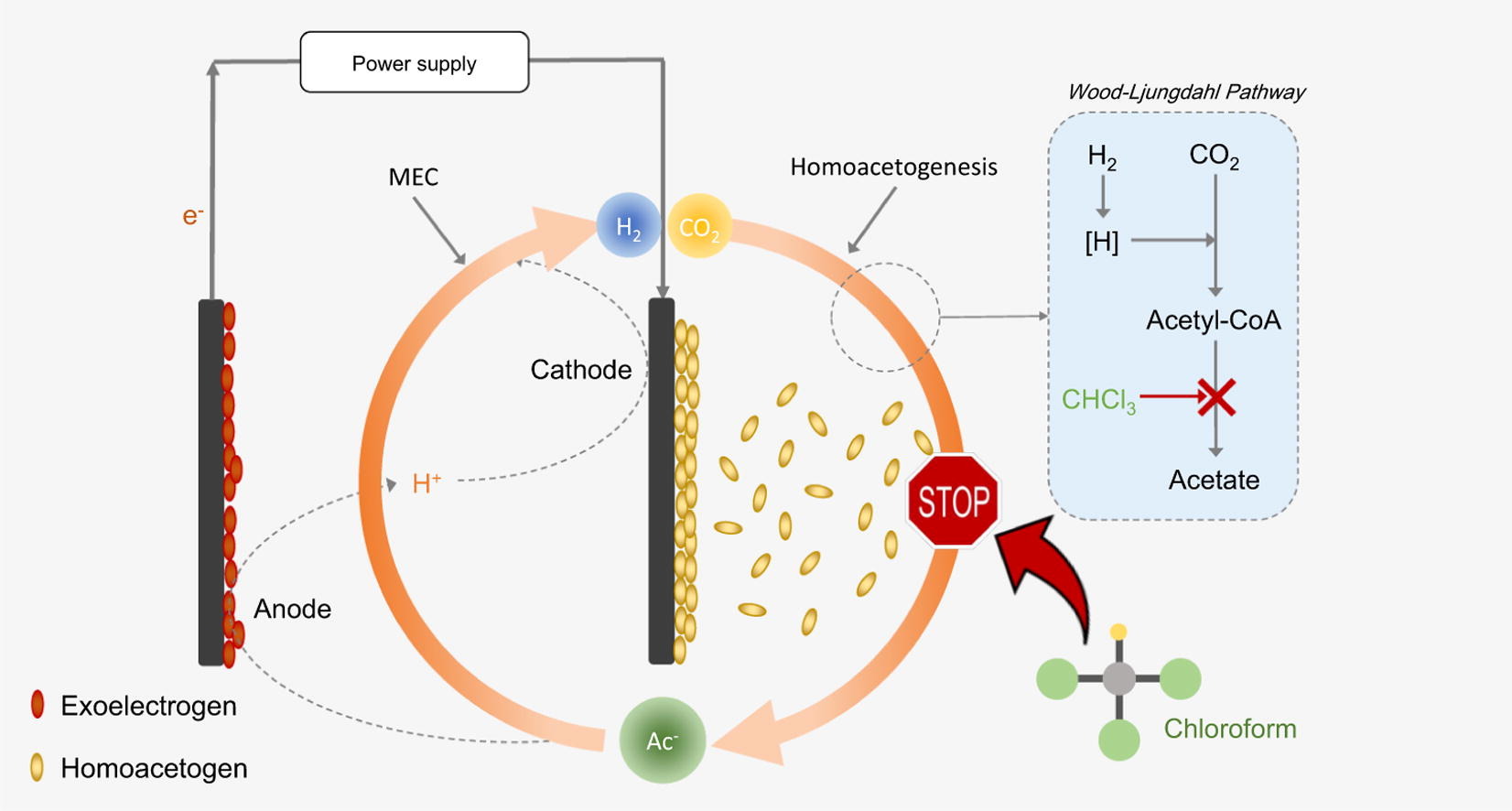 Method to inhibit homo acetogenins in bioelectrochemical fuel cells
Method to inhibit homo acetogenins in bioelectrochemical fuel cells
A small concentration of chloroform is used in the process, which after the experiment leaves traces of merely 0.001% which is negligible. Furthermore, 0.02 ml chloroform is used in ten litres of reactors, negating the chance of causing damage to the environment. “Microbial community analysis revealed that the amount ofhomoacetogenic Acetobacterium spp. was eliminated in the cathodic biofilms and planktonic cells by chloroform.”, enlightens Dr. Lakhveer. This method can also be applied in large scale reactors to enhance hydrogen production by inhibiting homo acetogenins. The hydrogen production rate is nearly 20 litres per hour from the reactor. The application of this reactor is the production of energy which can be used as an alternative to conventional fuel.
Advancing the work, Dr. Lakhveer aspires to improve this method in the future, through reducing the residual chloroform concentration and developing more environment-friendly inhibitor using similar mechanisms, that may lead to the practical application in MECs.
- Published in News, Research News
Synthesis of highly emissive and color tuanble CsPbBr3 Perovskite Nanocrystals via simple anion exchange
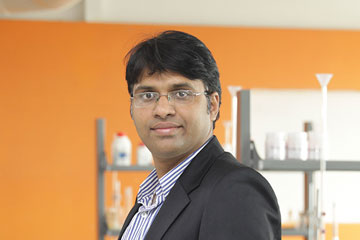 Dr. Nimai Mishra, Assistant Professor, Department of Chemistry, along with his research group comprising of his Ph.D. students Ms. V.G.Vasavi Dutt and Mr. Syed Akhil have published their recent work on “Fast, Tunable and Reversible Anion-Exchange in CsPbBr3 Perovskite Nanocrystals with Hydrohalic Acids” in the Journal “CrystEngComm”, Royal Society of Chemistry with an Impact factor 3.38.
Dr. Nimai Mishra, Assistant Professor, Department of Chemistry, along with his research group comprising of his Ph.D. students Ms. V.G.Vasavi Dutt and Mr. Syed Akhil have published their recent work on “Fast, Tunable and Reversible Anion-Exchange in CsPbBr3 Perovskite Nanocrystals with Hydrohalic Acids” in the Journal “CrystEngComm”, Royal Society of Chemistry with an Impact factor 3.38.
 Cesium-lead-halide perovskite nanocrystals In the research work, Dr. Mishra’s group has developed a very simple facile synthesis process of perovskite nanocrystals with very high emissive properties and colour tunability. Colloidal caesium-lead-halide perovskite nanocrystals (NCs) (CsPbX3, X = Cl, Br, I) are presently on-demand because of their excellent photoluminescence quantum yield (PLQY), wide range of band gap tunability and defect tolerance, finding its application as photodetectors, light-emitting diodes (LEDs), asing, and photovoltaics. Dr. Mishra informs, “Anion ( the halides) exchange in colloidal caesium-lead- halide perovskite nanocrystals (NCs) is a highly efficient protocol to tune their chemical composition and optoelectronic properties. In this work, we first report the use of hydrohalic acids (HX; X=Cl and Br) as a precursor for anion exchange which can be an efficient way to control the composition and optical properties of CsPbBr3 perovskite nanocrystals (NCs).” Furthermore, the team demonstrated a facile and efficient approach of anion-exchange which is implemented to tune the optical properties of CsPbX3 perovskite NCs via a simple post-synthetic modification with hydrohalic acids. Importantly, this work presents a simple, feasible, reproducible synthetic route toward control halide exchange in metal halide perovskite NCs with various optoelectronic properties.
Cesium-lead-halide perovskite nanocrystals In the research work, Dr. Mishra’s group has developed a very simple facile synthesis process of perovskite nanocrystals with very high emissive properties and colour tunability. Colloidal caesium-lead-halide perovskite nanocrystals (NCs) (CsPbX3, X = Cl, Br, I) are presently on-demand because of their excellent photoluminescence quantum yield (PLQY), wide range of band gap tunability and defect tolerance, finding its application as photodetectors, light-emitting diodes (LEDs), asing, and photovoltaics. Dr. Mishra informs, “Anion ( the halides) exchange in colloidal caesium-lead- halide perovskite nanocrystals (NCs) is a highly efficient protocol to tune their chemical composition and optoelectronic properties. In this work, we first report the use of hydrohalic acids (HX; X=Cl and Br) as a precursor for anion exchange which can be an efficient way to control the composition and optical properties of CsPbBr3 perovskite nanocrystals (NCs).” Furthermore, the team demonstrated a facile and efficient approach of anion-exchange which is implemented to tune the optical properties of CsPbX3 perovskite NCs via a simple post-synthetic modification with hydrohalic acids. Importantly, this work presents a simple, feasible, reproducible synthetic route toward control halide exchange in metal halide perovskite NCs with various optoelectronic properties.
Regarding the future scope of the research, Dr. Mishra informs, “These high-quality nanocrystals have the potential to be used as active material in LED devices, therefore our future plan is to make a prototype LED devices using our nanocrystals.”
Dr. Nimai Mishra is keen to collaborate, interested researchers may kindly contact him at nimai.m@srmap.edu.in
- Published in Research News
SRM AP organizes Webinar on “Inspire the Inspired: Excellent Research Opportunity in SRM University – AP”
The illuminating webinar on “Inspire the Inspired: Excellent Research Opportunity in SRM University – AP” was designed to describe the exciting research opportunities that are available at SRM University-AP, Andhra Pradesh. Prof. V.S. Rao, Vice-Chancellor, addressed the participants of the webinar with the opening remarks. He extended a warm welcome to the partakers, which was over 130. This impromptu webinar was organized to motivate the prospective Ph.D. students to join SRM AP for an illustrious career. Prof. V.S. Rao said, “SRM AP is pursuing the path of excellence by emphasizing research both in undergraduate (UG) and postgraduate (PG) level which played a crucial role in achieving the university’s aspiration to become an academy of distinction.” He highlighted that right from its inception, the University decided to recruit well-accomplished research-oriented faculty who have acquired a Ph.D. from reputed institutes or/and have international exposure. In its nascent stage, the faculty of SRM AP have published more than 200 papers in well-reputed journals with high Impact Factors.” Prof. V.S. Rao also applauded the incredible accomplishment of the faculty in getting 24 projects with a total outlay of Rs.12 crores from the Government of India Scientific Funding agencies in a short span. He added, “Committed, dedicated faculty working have worked relentlessly in the pursuit of excellence under the guidance of Prof. D. Narayana Rao, Pro Vice-Chancellor, whose leadership has steered their efforts in the best direction.”
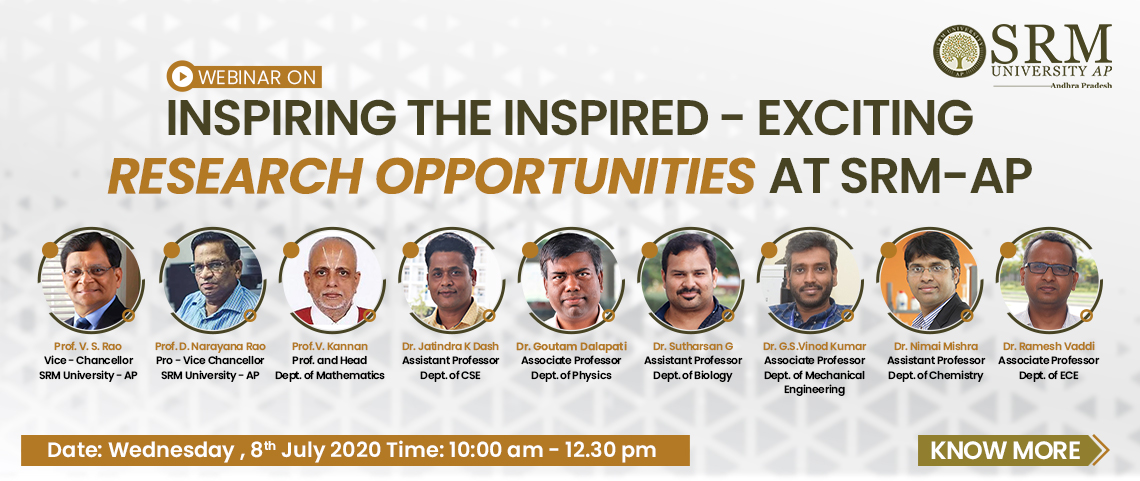 Prof. V.S. Rao concluded by mentioning that in India, research has taken a backseat as our nation is far behind other countries in producing Ph.D. students. “Now the time has come for higher education institutes to participate in Research and Development (R&D) by encouraging Ph.D. students. It is a matter of pride that at SRM AP, the faculty have involved undergraduate (UG) students in their research pursuits and publications.”, divulged Prof. V.S. Rao.
Prof. V.S. Rao concluded by mentioning that in India, research has taken a backseat as our nation is far behind other countries in producing Ph.D. students. “Now the time has come for higher education institutes to participate in Research and Development (R&D) by encouraging Ph.D. students. It is a matter of pride that at SRM AP, the faculty have involved undergraduate (UG) students in their research pursuits and publications.”, divulged Prof. V.S. Rao.
Prof. D. Narayana Rao asserted, “SRM AP provides exciting and challenging research opportunities that are of national importance and having social applications”. He welcomed all the participants of the webinar by explaining that the purpose of the webinar was to explicate the type of exciting research in frontline and emerging areas of science and technology being carried out at SRM AP. Through the webinar, he desired to motivate the students to join the Ph.D. programs at SRM AP by assuring them of an enviable career. He substantiated his statement by stating that all the faculty at SRM AP have obtained their Ph.D. from reputed institutes in India and abroad.
Prof. D. Narayana Rao initiated his presentation by displaying the model plan of SRM AP that is to be constructed in the next 5-10 years to explain the conducive environment offered at the university for creative thinking. Inaugurated on 15 July 2017, within 3 years, expert faculty with brilliant accomplishments and national and international characteristics have been associated with SRM AP. Prof. D. Narayana Rao described and explained various laboratories, experimental facilities, and world-class infrastructure of the university.
Prof. D. Narayana Rao informed the attendees of the webinar regarding the 132 faculty members, cross-cultural students, periodic research review meetings, and Active Learning centers at SRM AP which facilitates discussion among scholars and formation of innovative ideas. He added, “It is of honour and pride for our university to have INSPIRE faculty and students who have published journal papers having Impact Factor of more than 52. It is of prestige and privilege for any university to reach this stage within 3 years of its inception. We also involve UG students in research and one of them has developed Face Shield and patented the same.”
Prof. D. Narayana Rao enlightened about the collaborations of SRM AP with Indian Nanoelectronics User Program- The Indian Institute of Science (INUP-IISc), which would enable students to work at such centers, interact with faculty members of IISc, and expand their horizons of thinking and carrying out research. Prof. D. Narayana Rao declared that SRM AP has collaborated with National Atmospheric Research Laboratory (NARL) of Indian Space Research Organization (ISRO) in emerging areas of studies which are of paramount importance. He urged, “The students can explore these facilities and use the wisdom of many of the eminent personalities who would direct and guide students to conduct contemporary research.”
Prof. D. Narayana Rao notified the participants about the importance of Computational Materials. He said, “Previously, designing and developing materials used to take a decade. Now with computational materials, the same can be achieved in reduced time. SRM AP organized a conference with The Asian Consortium on Computational Materials Science (ACCMS) on 5th-6th February 2020. (For details, visit: https://srmap.edu.in/conferences/third-international-conference/)”. Prof. D. Narayana Rao further informed, “SRM AP has established centers in collaboration with Amara Raja Batteries to develop Lithium-ion (Li-ion) batteries. Dr. G. S. Vinod Kumar, Associate Professor, Department of Mechanical Engineering, has been working with Tanishq-Titan to develop lightweight jewellery using foam gold, which has also been filed for patenting. Apart from this, it is of extreme privilege that SRM AP is work in partnership with the Indian Railways to develop hydrogen infused trains”
Prof. D. Narayana Rao concluded by saying that SRM AP provides challenging and exciting research opportunities that cater to the industrial requirements. He motivated the prospective Ph.D. students to join SRM AP to develop vision, expertise, and commitment that would enable them to become leaders in their chosen areas of science and technology.
Further, the webinar steered students to seven breakout rooms where Dr. Goutam Kumar Dalapati represented Physical Science, Dr. Nimai Mishra spoke for Chemical Science, Prof. V. Kannan embodied Mathematics, Dr. Manjunatha Thondamal represented Biological Science, Dr. Jatindra Kumar Dash exemplified Computer Science and Engineering, Dr. Ramesh Vaddi spoke about Electrical and Electronics Engineering and Electronics and Communication Engineering, and Dr. G. S. Vinod Kumar gave a detailed presentation of the research activities of the Department of Mechanical Engineering. Faculty members shared details of SRM AP research programmes through presentations in each breakout room, and the participants interacted with them to discuss various plausible research areas.
- Published in News, Research News, Research Webinars, Webinars
Dr. Lakhveer Singh appointed in the Editorial Board of Journal Biomass conversion and Biorefinery
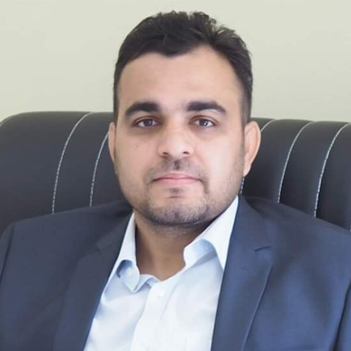 Dr. Lakhveer Singh, Assistant Professor, Department of Environmental Science has been appointed in the Editorial Board of Journal Biomass conversion and Biorefinery (IF 2.60), a reputed journal published by Springer Nature from Germany. Journal Biomass conversion and Biorefinery have eminent scientists and professors from the top-notch institutes such as the Imperial College, London, University of British Columbia, University of California, Utrecht University, and many others of the same accord in their Editorial Board.
Dr. Lakhveer Singh, Assistant Professor, Department of Environmental Science has been appointed in the Editorial Board of Journal Biomass conversion and Biorefinery (IF 2.60), a reputed journal published by Springer Nature from Germany. Journal Biomass conversion and Biorefinery have eminent scientists and professors from the top-notch institutes such as the Imperial College, London, University of British Columbia, University of California, Utrecht University, and many others of the same accord in their Editorial Board.
Dr. Lakhveer is the second Indian till date to join the Editorial Board of Journal Biomass Conversion and Biorefinery. To add credibility to the journal and/or commemorate important experts in the field, the journal appoints eminent contributors in its editorial board. This honourable position is offered by the journal to Dr. Lakhveer because of his excellent research and publication track record. He has been working in the area of Energy Production and Biomass Conversion which are relevant to the journal’s scope, and has published more than 65 research articles and 6 books in the domain. Dr. Lakhveer says, “Every journal depends on its editor(s) and board to leave an impact on the society’s development. This is really a great achievement for me as well as good for the University’s recognition across the globe.”
The primary functions of being an editorial board member include writing editorials, commenting on special issues, serving as high-volume reviewers of submitted articles, evaluating and managing editors and publishers, assessing their journal and the review process, partaking in long-term planning for the journal, and discussing special features and financial issues.”
Dr. Lakhveer aspires to continue contributing substantially to the research and development in the field of Energy Production and Biomass Conversion and effectively execute the responsibilities endowed to him by the journal in the coming days.
- Published in News, Research News
SRM AP faculty receives the prestigious grant by DBT/Wellcome Trust India Alliance
Investigating giant bacterial viruses to explore the origin of cellular complexity
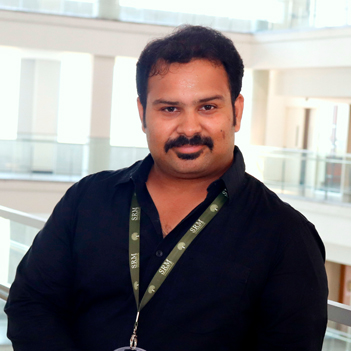 Dr. Sutharsan Govindarajan, Assistant Professor, Department of Biological Sciences, SRM University-AP has been awarded the prestigious ‘Early Career Fellowship’ grant by DBT/Wellcome Trust India Alliance, funded by the Department of Biotechnology (DBT) and the Wellcome Trust, United Kingdom. The fellowship supports outstanding young scientists to pursue high-quality research in the field of biomedical science and establish themselves as independent researchers in India. Dr. Sutharsan sought a total research grant of 1.1 crore for a period of 5 years as a DBT/Wellcome Trust India Alliance Early career fellow. The India Alliance grants are highly competitive and is based on the profile of the applicant and the novelty and the importance of the proposed research. Nationwide only less than 10 Early Career grants are awarded every year. Dr Sutharsan is a highly accomplished scientist, having published research articles in highly reputed journals, including the most prestigious Nature and Nature Microbiology. Through this fellowship, Dr. Sutharsan will establish an independent research laboratory at SRM University – AP with the support of Prof. Jayaseelan, Head, Department of Biological Sciences, and the fellowship supervisor of the project.
Dr. Sutharsan Govindarajan, Assistant Professor, Department of Biological Sciences, SRM University-AP has been awarded the prestigious ‘Early Career Fellowship’ grant by DBT/Wellcome Trust India Alliance, funded by the Department of Biotechnology (DBT) and the Wellcome Trust, United Kingdom. The fellowship supports outstanding young scientists to pursue high-quality research in the field of biomedical science and establish themselves as independent researchers in India. Dr. Sutharsan sought a total research grant of 1.1 crore for a period of 5 years as a DBT/Wellcome Trust India Alliance Early career fellow. The India Alliance grants are highly competitive and is based on the profile of the applicant and the novelty and the importance of the proposed research. Nationwide only less than 10 Early Career grants are awarded every year. Dr Sutharsan is a highly accomplished scientist, having published research articles in highly reputed journals, including the most prestigious Nature and Nature Microbiology. Through this fellowship, Dr. Sutharsan will establish an independent research laboratory at SRM University – AP with the support of Prof. Jayaseelan, Head, Department of Biological Sciences, and the fellowship supervisor of the project.
In this project, Dr. Sutharsan plans to venture and explore the biology of a novel class of bacteriophages called Jumbo-phages. “Bacteriophages, which are the most abundant biological entities on the planet, are viruses that infect bacteria but do not harm humans. Jumbo-phages, as the name suggests, are giant viruses with large genome. A sneak peek into their lifestyle during my postdoctoral research led me, to realize that these phages build fascinating complex structures inside the bacteria they infect. Such complex structures are well known to be formed in eukaryotic cells like human cells but was not thought to be made by bacteriophages, which have evolved billions of years before eukaryotes. Thus, studying how such cellular structures are formed by jumbo-phages provides a unique opportunity to investigate the origin of complex life” informs Dr. Sutharsan. He also explains that the proposed research has several biotechnological applications such as phage therapy and synthetic biology.
Dr. Sutharsan further shares, “This is one the best fellowships, a young scientist can obtain in India. It is an honour, prestige and a recognition for the scientist as well as to the University. In the next 5 years, I anticipate major fundamental discoveries in the field of bacteriophage biology and evolution”.
- Published in News, Research News
Energy-Efficiency Optimization over Full-Duplex IoT Networks Towards Commercial Applications
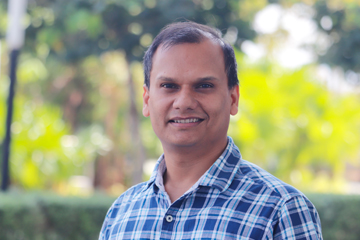 Dr Om Jee Pandey Two research papers of Dr Om Jee Pandey, Assistant Professor, Department of Electronics and Communication Engineering, have been accepted in reputed IEEE Journals. The papers titled “Multiuser Full-Duplex IoT Networks with Wireless-Powered Relaying: Performance Analysis and Energy Efficiency Optimization,” and “Time Synchronized Node Localization Using Optimal H-Node Allocation in a Small World WSN” are going to be published in IEEE Transactions on Green Communications and Networking and IEEE Communications Letters, respectively. The paper “Multiuser Full-Duplex IoT Networks with Wireless-Powered Relaying: Performance Analysis and Energy Efficiency Optimization,” was pursued in collaborations with Prof. Ha H. Nguyen, Department of Electrical and Computer Engineering, University of Saskatchewan, Saskatoon, Canada, and Dr Mahendra K. Shukla, who is associated with Macau University of Science and Technology as a Post Doctoral Fellow.
Dr Om Jee Pandey Two research papers of Dr Om Jee Pandey, Assistant Professor, Department of Electronics and Communication Engineering, have been accepted in reputed IEEE Journals. The papers titled “Multiuser Full-Duplex IoT Networks with Wireless-Powered Relaying: Performance Analysis and Energy Efficiency Optimization,” and “Time Synchronized Node Localization Using Optimal H-Node Allocation in a Small World WSN” are going to be published in IEEE Transactions on Green Communications and Networking and IEEE Communications Letters, respectively. The paper “Multiuser Full-Duplex IoT Networks with Wireless-Powered Relaying: Performance Analysis and Energy Efficiency Optimization,” was pursued in collaborations with Prof. Ha H. Nguyen, Department of Electrical and Computer Engineering, University of Saskatchewan, Saskatoon, Canada, and Dr Mahendra K. Shukla, who is associated with Macau University of Science and Technology as a Post Doctoral Fellow.
 Block diagram of the full-duplex
Block diagram of the full-duplex
wireless-powered relay based on power splitting There has been a growing interest in improving energy efficiency for next-generation Internet of Things (IoT) networks due to the increasing demand for green communications. Motivated by this demand, energy efficiency maximization has been investigated for several networks. Specifically, without considering simultaneous wireless information and power transfer networks, various works have extensively studied energy efficiency maximization for half-duplex networks and full-duplex networks. Further, by considering simultaneous wireless information and power transfer networks, several works have examined energy efficiency maximization in half-duplex networks. Moreover, energy efficiency for next-generation IoT networks with simultaneous wireless information and power transfer has also been studied by considering half-duplex transceivers. It appears that energy efficiency problems for multiuser full-duplex IoT networks have not been studied in the open literature.
 Multiuser FD-IoT network with
Multiuser FD-IoT network with
wireless-powered TWR Motivated by the above discussion, in this work we consider a full-duplex IoT network in which a multi-antenna access point and several single antenna IoT devices exchange information bidirectionally with the aid of a wireless-powered single-antenna relay, under generalized Nakagami-m fading channels. In particular, we consider the power splitting protocol at the full-duplex relay terminal, and each communication terminal operates in the full-duplex mode. For such a network, we first formulate the instantaneous end-to-end signal-to-interference-plus-noise ratios (SINRs) by employing maximum-ratio transmission (MRT) beamforming and maximum-ratio combining (MRC) at the access point A, as well as IoD scheduling. Then, based on the obtained SINRs, we evaluate the overall outage probability and ergodic sum-rate of the network. Furthermore, we develop an optimal power allocation to maximize the network’s EE.
 Integral area for the
Integral area for the
overall outage probability Recently, with many technological advancements in wireless data transmission, IoT is expected to affect all aspects of our daily lives with its ever-growing and emerging applications. Traditional wireless communication networks are usually limited by the operational time of energy-constrained devices, and therefore energy consumption minimization is a crucial factor in IoT networks. Simultaneous wireless information and power transfer have emerged as a sustainable solution to the scenarios where replacing or recharging batteries is very costly, and may even be impossible. The basic idea of simultaneous wireless information and power transfer is that since radio frequency signals can carry information and energy at the same time, the received radio frequency signals can be utilized for energy harvesting to keep the energy-constrained devices operational. Existing studies adopt two different protocols, namely time switching and power switching, to implement simultaneous wireless information and power transfer receiver architecture. With these protocols, either the power or time of the received signal is split so that one part is used for information processing, and the other is used for energy harvesting.
The proposed research can play a crucial role in societal development as it can be applied in developing many state-of-the-art applications in the areas related to green healthcare systems, energy-efficient agriculture systems, green transportation, low power home automation, green manufacturing, low power smart utilities, and energy-efficient industries etc.
His other paper “Time Synchronized Node Localization Using Optimal H-Node Allocation in a Small World WSN”, DOI (identifier) 10.1109/LCOMM.2020.3008086, has been done in collaborations with Prof. Rajesh M Hegde, Department of Electrical Engineering, IIT Kanpur and Dr Mahendra K. Shukla, Post Doctoral Fellow at Macau University of Science and Technology. To know more about Dr Pandey’s work in the domain of Small-World Wireless Sensor Network, visit- https://srmap.edu.in/news/dr-om-jee-pandey-small-world-wireless-sensor-network-help-making-smart-applications-industries/.
Dr Pandey is now not only working for the commercial applications of his current research but also has devoted himself to his future projects, that include-
Full-Duplex Network Development for Green Healthcare Systems.
Energy-Efficient Cyber-Physical Systems and Internet of Things.
Development of Energy-Efficient Agriculture Systems.
Green and Intelligent Transportation over Full-Duplex Context-Aware Pervasive Systems.
- Published in ECE NEWS, Faculty, News, Research News
SRM AP organized webinar on “EFFECTIVE WAYS OF WRITING RESEARCH ARTICLE”
Prof Shobhana Narasimhan on “How to publish without perishing”
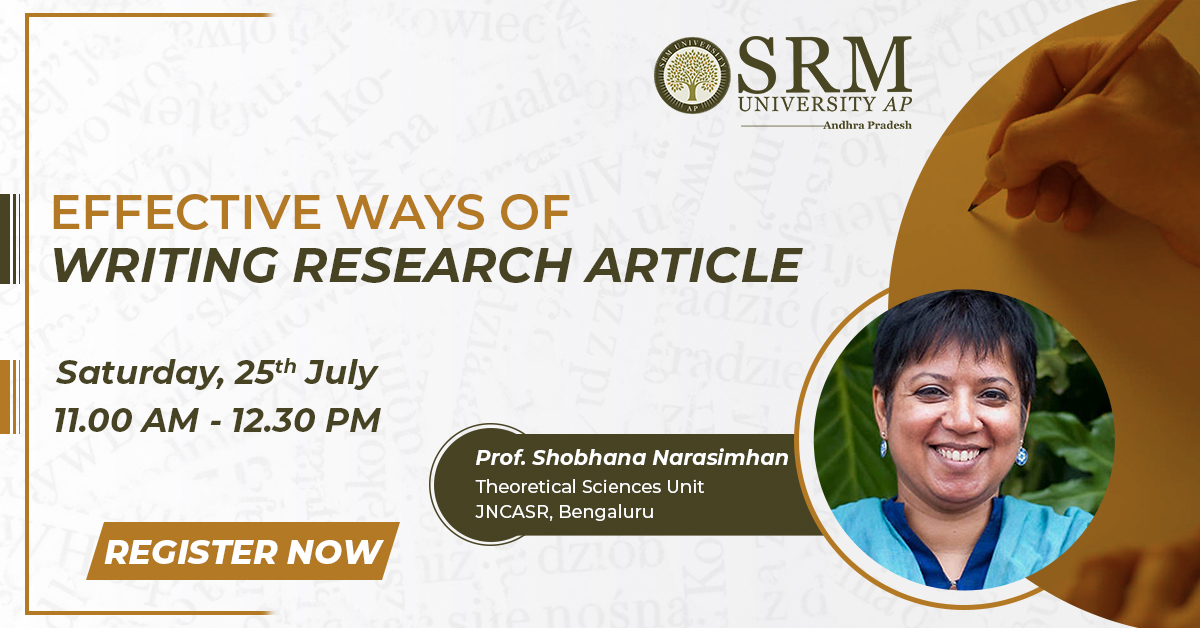 SRM University-AP, Andhra Pradesh organized a webinar titled “EFFECTIVE WAYS OF WRITING RESEARCH ARTICLE” to enhance the opportunities endowed to young scholars that would enable them to demonstrate their expertise and improve their critical analyzing skills. Prof D. Narayana Rao, Pro-Vice Chancellor, welcomed the guest speaker Prof Shobhana Narasimhan, Theoretical Sciences Unit, Jawaharlal Nehru Centre for Advanced Scientific Research (JNCASR), Bengaluru, and participants of the webinar through his opening remarks. Prof D. Narayana Rao explained the importance of higher education and research as they are critical contributors to sustainable livelihood and the economic development of the nation. He said, “Research serves as a hub to harbour innovative ideas that enlighten and propel the country forward socially, culturally, scientifically, technologically, and economically. In view of the requirements of the 21st century, the aim of quality university education is to develop good well rounded and creative individuals. Higher education and research must enable knowledge creation and innovation, thereby contributing to the economy.”
SRM University-AP, Andhra Pradesh organized a webinar titled “EFFECTIVE WAYS OF WRITING RESEARCH ARTICLE” to enhance the opportunities endowed to young scholars that would enable them to demonstrate their expertise and improve their critical analyzing skills. Prof D. Narayana Rao, Pro-Vice Chancellor, welcomed the guest speaker Prof Shobhana Narasimhan, Theoretical Sciences Unit, Jawaharlal Nehru Centre for Advanced Scientific Research (JNCASR), Bengaluru, and participants of the webinar through his opening remarks. Prof D. Narayana Rao explained the importance of higher education and research as they are critical contributors to sustainable livelihood and the economic development of the nation. He said, “Research serves as a hub to harbour innovative ideas that enlighten and propel the country forward socially, culturally, scientifically, technologically, and economically. In view of the requirements of the 21st century, the aim of quality university education is to develop good well rounded and creative individuals. Higher education and research must enable knowledge creation and innovation, thereby contributing to the economy.”
Prof D. Narayana Rao believes that institutes must build expertise that will impact the society for the next 3 decades and beyond. Prof D. Narayana Rao explained, “Simply tailoring people into jobs that exist today but are likely to change or disappear in the coming years, is suboptimal and even counterproductive. The universities and educational institutions need to instill the thought process and inquisitiveness among students by going beyond the classroom and expanding the frontiers of knowledge.” He urged that there is a dire need to emphasize the pride and prestige associated with research to make the students feel honoured and excited for undertaking scientific pursuits. Prof D. Narayana Rao informed, “At SRM AP, we encourage undergraduate and graduate students to get involved in research. This country has the legacy of producing young scientists who have published papers in highly reputed journals. Realizing that, we do encourage undergraduate students to get involved with research and publish papers in good journals. This also familiarizes our students to a research-intensive environment, benefiting them in their future endeavours”. Prof D. Narayana Rao concluded by requesting Prof Shobhana Narasimhan to motivate the students to carry out research and publish good research journals, believing that she will hypnotize the participants and inspire them to succeed.
Prof Shobhana Narasimhan began the presentation, “How to publish without perishing” with the purpose of improving the articles so that they find places in good journals. She initiated her talk by saying that writing papers is an integral part of the scientific research pursuits. Quoting Francois Arago: “To get to know, to discover and to publish in the destiny of the scientist”, and Robert Boyle: “Writing about science should be clear but it can also be made beautiful”, she explained the rules of effective research writing.
Prof Shobhana Narasimhan said that foremost, one needs to identify the reason for their willingness to write a paper. Further, she elaborated on the first rule of effective writing by mentioning that one should choose the journal carefully before writing the paper as the article should be aligned to the requirements and regulations of the particular journal in mind. Also, she suggested that one has to consider the extent of the readership of the journal, difficulty in getting the paper published in the journal, prestige associated with publishing in the journal, payment involved with the publishing, and the time required for the article to be published in the journal. She also said, “Often, invitations come from predatory journals and one should research carefully regarding the same. A publish in a predatory journal becomes a black mark in your career. It is better to go through the struggle of publishing in a respected journal than to go for the easy options”.
Prof Shobhana Narasimhan also speaks of constructing a story while writing the paper. She insisted, “The most important rule is to narrate a story while writing a paper. It is not just about calculations and results.” She explained the 3 steps associated with constructing the story. First, the research scholars require to ‘assemble the materials’. Depending on the requirement, one can use either of the three techniques: ‘mind maps’ which works better when there is one main concept and one can start from the centre, the second is ‘concept maps’ which works better when one has several related concepts and can use a flowchart to structure it from the top, and the third one is ‘timelines’ which works mostly with review articles, where a chronological sequence is used to assemble the materials. Prof Shobhana Narasimhan moved on to discuss the second step – ‘keeping and discarding information’. She used a schematic diagram to explain the usual proceedings of a scientific research. She said, “The path to scientific discovery is a complex tree-like structure. One does not need to describe all the blind alleys encountered during the research, a specific and balanced representation would be the ideal path to traverse.” Further, in the third step, one must ‘arrange the materials in a sequence’ which can be chronological or logical. Prof Shobhana Narasimhan informed, “In a scientific paper, a logical sequence is usually preferred. Play with the facts and results to construct a narrative and structure the argument in a flowchart to improve the efficiency.”
Prof Shobhana Narasimhan explained another rule: ‘clear what your message is’. She said, “The article should not be too clear, but it should be as clear as possible. Possible messages that one can provide in a paper include the most significant result, the second most significant result, new techniques and approach presented in the work or the existing method used in a new area, and whether the work contradicts/confirms the existing expectations.” She concluded by mentioning that the scholars need to tailor the paper to the journal’s audience by considering whether they are likely to be experts or laymen. This would allow the writer to construct the appropriate language for the paper and decide on the extent of information to be shared. She also urged researchers to use simple words when possible, check for grammatical errors, avoid plagiarism, abide by the journal’s style guidelines, and include a cover letter to increase the probability of getting their research articles published in reputed journals.
- Published in News, Research News, Webinars
Artificial Intelligence: The Future of Healthcare in India
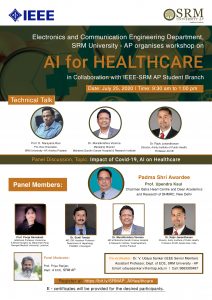 Department of Electronics and Communication Engineering, SRM University-AP, Andhra Pradesh organised an insightful workshop on “Artificial Intelligence (AI) for Healthcare” in collaboration with IEEE-SRM AP Student Branch on 25th July. Prof. D. Narayana Rao, Pro-Vice-Chancellor, inaugurated the session. The workshop was divided into two sessions.
Department of Electronics and Communication Engineering, SRM University-AP, Andhra Pradesh organised an insightful workshop on “Artificial Intelligence (AI) for Healthcare” in collaboration with IEEE-SRM AP Student Branch on 25th July. Prof. D. Narayana Rao, Pro-Vice-Chancellor, inaugurated the session. The workshop was divided into two sessions.
1. Technical presentation
2. Panel discussion
Dr Muralikrishna Voonna, Managing Director, Mahatma Gandhi Cancer Hospital & Research Institute, and Dr Rajiv Janardhanan, Director, Amity Institute of Public Health, Professor ACVB participated in the technical presentation. Dr Voona delivered a lecture on “Impact of AI in Clinical Healthcare” whereas Dr Rajiv Janardhanan spoke on “Sustainable Healthcare: AI-enabled platforms for Affordable and Accessible Healthcare Solutions”.
Eminent panellists such as Padma Shree Awardee Prof. Upendra Kaul, Dr Pooja Ramakant, Dr Sunil Taneja, Dr Muralikrishna Voonna, and Dr Rajiv Janardhanan interacted on “Impact of Covid-19, AI on Healthcare” during the second half of the session. Prof. Priya Ranjan, Department of ECE, SRM-AP, acted as the moderator of the session. Dr Udaya Shankar V, Assistant Professor, Department of ECE, was the coordinator of the workshop.
In his opening remarks, Prof. D. Narayana Rao asserted that healthcare in India faces significant challenges on quality, accessibility and affordability for a large section of the Indian population. Many healthcare experts are aware that in India, 70% of healthcare infrastructures are in the cities which caters only to 30% of India’s Population. “The shortage of doctors, lack of infrastructures, different mindset about the urban and rural population of the country and low government spending on the healthcare are very much motivating India towards innovative and sustainable and affordable technology to improve the quality of life,” said Prof Rao. He further mentioned that AI in Indian healthcare is expanding at a significant rate of 40% approximately. The AI-enabled health services such as automated analysis of medical tests, predictive healthcare diagnosis with the help of monitoring equipment and wearable sensor-based medical devices are expected to revolutionise medical treatment process in the country. AI is being extensively used in six healthcare segments such as hospital administration, pharmaceuticals, diagnostics, medical equipment and supplies, medical insurance and telemedicine. “Moreover, hospitals can implement patient-centric plans with the help of AI to avoid unnecessary hospital procedures and making healthcare services faster in India. The Government of India also shows its keen inclination as in the past week, the Hon’ble prime minister Sri Narendra Modi had a discussion with the CEO of IBM regarding the development of AI-enabled medical instruments for healthcare in the country. Needless to say, there are a plethora of opportunities for new engineers and doctors,” opined Prof Rao.
In his talk, Dr Murali Krishna Voonna confirmed that Artificial intelligence has a huge potential to become a transformational force in healthcare. It allows humans to gain unprecedented insights into diagnosis, care process, treatment variability and patient outcomes. Nowadays, machine learning uses statistical technics to give computing systems to learn with incoming data to identify patterns and make decisions which will help the doctors to assess risks, make a correct diagnosis, and offer more effective treatments. Robot-assisted surgery is now being widely popular for the precision and accuracy in performing a complicated surgery. AI is world’s one of the highest growth industries projected to reach $150 billion by 2026. It can compensate for physician biases and be used in personalised therapy by studying genome. Dr Voonna further informed that there is a huge scope for development in the segments such as brain-computer interface, next-generation radiology tools, creation of precise analytics for pathology images, expanding access to treat underserved regions, clinical decision support etc. to name a few. “Several reputed companies have invested in India to improve the AI in healthcare. NITI Aayog is working with Google to develop artificial intelligence ecosystems in India both in training and research. They have started a National Research Strategy for Artificial Intelligence recently. National Digital Health Authority has been formed as a regulatory body which is going to make the regulation in the Artificial Intelligence in start-ups and business and commercialisation of the products. Still, AI in healthcare is a decision support tool but not a decision-making tool,” explained Dr Voonna.
In the opinion of Dr Rajiv Janardhanan, the healthcare disparity continued because the investments of the government in the years after independence is less than 2 %. COVID-19 has turned out to be a blessing for health care as it made people especially policy-makers to realise that the healthcare infrastructure needs to be improved drastically. The AI-enabled intelligent support system is required because of budget constraints, rising costs of advanced medical treatments, increased complexity and cost of delivering healthcare, as well as increased expectations and demand for quality patient-centred healthcare. India comprises of a healthcare ecosystem where 80% of the healthcare is expensive, and 70% of the population is living in rural areas with marginalised and inaccessible healthcare. This makes the rationale to develop tools which are community empowering. “Knowledge dissemination of health literacy is required necessarily to increase the productive hours of the nation. When we empower the stakeholders with health literacy it directly aligns with the health promotion efforts, provides a rationale with community-empowering policy decision making, where the weakest stakeholder in the healthcare system can be an active participant,” asserted Dr Janardhanan. AI-enabled tagging of data can convert precision medicine to a community-centric new system which is called precision public health. This conversion has to be technology-enabled with support from the engineering fraternity to make it affordable and accessible.
During the second half of the session, the panel discussed the impact of COVID-19 on health immunity system. Padma Shree Awardee Prof Kaul explained in detail how COVID-19 disease affects the human body and the process of vaccination. He gave a detailed overview of how vaccines are prepared and the process of a clinical trial. He further shared the updated information on the COVID-19 vaccine with particular focus on India’s progress in making the vaccine. Dr Taneja and Dr Ramakanth expressed their views on COVID situation based on their daily experience at the hospitals. The panel agreed that the adoption of artificial intelligence (AI) in the healthcare system enables healthcare services, delivered at a lower cost with increased efficiency and emphasis on the diagnostics. AI should be encouraged to be used in machines to predict, comprehend, learn and act. It has the ability to play the role of game-changer in the areas of wellness, early detection, diagnosis, decision making, treatment, end of life, research and training. However, some concerns related to the safety, data quality, accountability, transparency, legal aspects etc. still persists.
The enthralling session ended with the vote of thanks. The insightful event certainly helped the participants to understand the approach in which AI is reinventing and improving modern healthcare through technologies that can estimate, comprehend, explore, and perform effectively.
- Published in ECE NEWS, News, Research News, Research Workshop
2D nanomaterials for various sustainable applications
American Chemical Society publishes Dr Lakhveer Singh’s book on Advanced Applications of 2D Nanomaterials
 Dr Lakhveer Singh, Assistant Professor, Department of Environmental Science, SRM University-AP, Andhra Pradesh has edited a book on “Adapting 2D Nanomaterials for Advanced Applications” which is published in the globally renowned publishing house American Chemical Society. The book emphasizes on his collaborative work with Dr Durga Mahapatra, TERI Deakin Nanobiotechnology Center (TDNBC), TERI, India on 2D nanomaterials for various sustainable applications such as energy production and storage, biosensor, water treatment etc.
Dr Lakhveer Singh, Assistant Professor, Department of Environmental Science, SRM University-AP, Andhra Pradesh has edited a book on “Adapting 2D Nanomaterials for Advanced Applications” which is published in the globally renowned publishing house American Chemical Society. The book emphasizes on his collaborative work with Dr Durga Mahapatra, TERI Deakin Nanobiotechnology Center (TDNBC), TERI, India on 2D nanomaterials for various sustainable applications such as energy production and storage, biosensor, water treatment etc.
2D nanomaterials, or graphene equivalents, possess an exceptional array of characteristics due to their unique structure, configuration, and properties. Such materials have gained attention for countless applications due to their progression into wide varieties of crystallographic structures via abundant elemental compositions. These characteristics distinctively impart qualities to their unique chemical reaction capabilities and adjustable structural properties and therefore enable applications in energy transitions, storage, and conservation.
In his research, Dr Lakhveer has developed a variety of nanomaterials and catalysts having several applications. He mentions, “We have developed Mesoporous MnCo2O4 nanorods for electricity production, NiO, and CoO nanoparticles for biohydrogen production and Cu-ZnO nano heterojunction for degradation of chlorpyrifos pesticide.” Recently, Dr Lakhveer has developed reduced graphene oxide and silver nanoparticles on a melamine sponge skeleton by a simple coating method in collaboration with Oregon State University, USA, and Xiamen University, China. The modified sponge retained the high porosity of the sponge substrate and exhibited photothermal properties. This material provides a new idea for the recovery of heavy crude oil and provides new applications for photothermal-conversion materials.
Dr Lakhveer is currently vested in developing efficient and economical nanocatalysts that possess commercial applications in the energy and water sectors. In the next few months, he will be publishing two more books in the American Chemical Society (ACS) and Elsevier. These books will focus on novel electrodes, nano catalytic materials, and subnanometric-scale catalysts having applicability at the Nanoscale.
- Published in News, Research News
CSE student presented paper on Data Hiding
K. Sree Rama Murthy, Second Year B. Tech-CSE student presented a paper at a conference in IIT-Kharagpur
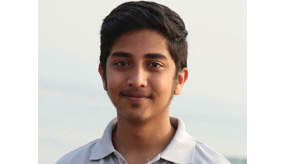 K. Sree Rama MurthySRM University-AP always inspires the students in their pursuits, be it a job of their choice or a career in research and higher studies. K. Sree Rama Murthy, a 2nd-year student of B.Tech in Computer Science and Engineering, has recently presented a research paper on “A Block-wise Histogram Shifting based Reversible Data Hiding Scheme with Overflow Handling” in the Eleventh International Conference on Computing, Communication and Networking Technologies (11th ICCCNT), held at IIT Kharagpur, India in association with IEEE Kharagpur Section, during July 1 – 3, 2020.
K. Sree Rama MurthySRM University-AP always inspires the students in their pursuits, be it a job of their choice or a career in research and higher studies. K. Sree Rama Murthy, a 2nd-year student of B.Tech in Computer Science and Engineering, has recently presented a research paper on “A Block-wise Histogram Shifting based Reversible Data Hiding Scheme with Overflow Handling” in the Eleventh International Conference on Computing, Communication and Networking Technologies (11th ICCCNT), held at IIT Kharagpur, India in association with IEEE Kharagpur Section, during July 1 – 3, 2020.
Data hiding is a process of embedding a secret message into a cover medium for secure message transmission. The reversible data hiding techniques are recently explored in the domain of data hiding in which the cover image can be recovered while extracting the hidden secret message. The overview of a reversible data hiding scheme is shown in Figure. 1.
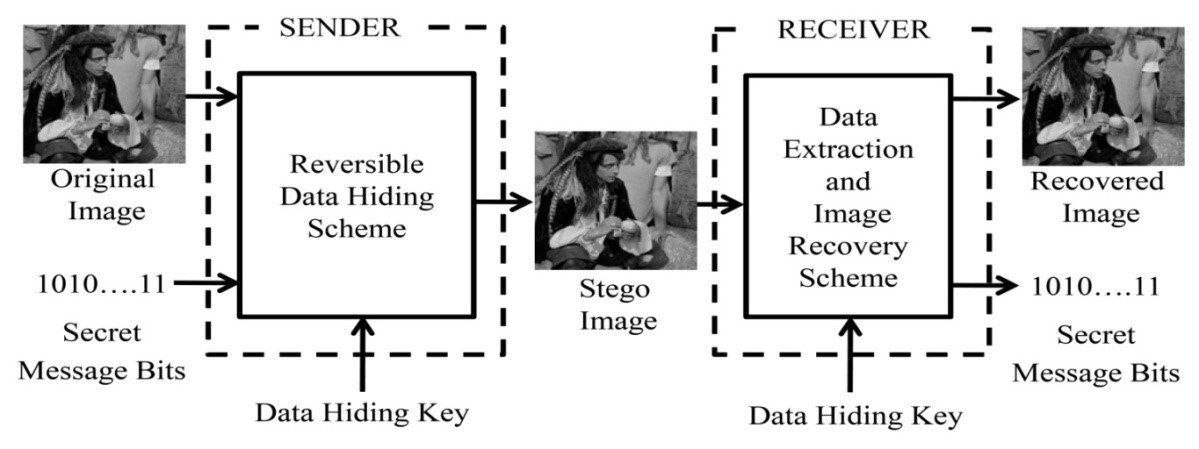 Figure 1. Overview of reversible data hiding
Figure 1. Overview of reversible data hiding
In this research paper, Sree Rama Murthy introduced a new reversible data hiding algorithm based on the histogram of the blocks of the cover images with an efficient overflow management technique to achieve a better embedding rate without compromising the visual quality of the stego image.
Design and development of reversible data hiding schemes are widely studied topic due to its wide scope in cloud computing and medical image transmission. This paper introduces a new reversible data hiding algorithm based on the histogram of the blocks of the cover images with an efficient overflow management technique. In the new scheme, the peak intensity value from each block is used for data hiding, and to make sure the correct recovery of the original image, the grayscale value used for data hiding from each block is embedded in the same block itself by replacing the least significant bits of eight selected pixels. The lossless recovery is ensured by embedding those least significant bits in the same block itself along with the secret message. Detailed theoretical analysis and experimental study of the scheme are carried out and discussed in this paper. The images from the standard image dataset of the University of Southern California (USC-SIPI) are used in their study.
“To be able to publish a research paper at such an early stage in a reputed conference like ICCCNT-2020 is an achievement that has acted as a cornerstone for my research aspirations. I feel highly encouraged, motivated and inspired to contribute more in the fields of research. I express my sincere gratitude to my professors, especially to Dr Manikandan V. M for providing me with the opportunity to collaborate. He put his trust on me, encouraged to do research with him and guided me with his knowledge and experience throughout the journey. I feel this is only the beginning for me, and I will try my best to accomplish more and retain more knowledge,” said Sree Rama Murthy.
Sree Rama Murthy plans to acquire a master’s degree in computer science and aspires to be a researcher who can make significant contributions in the domain of Computer Science and Engineering.
- Published in CSE NEWS, News, Research News

